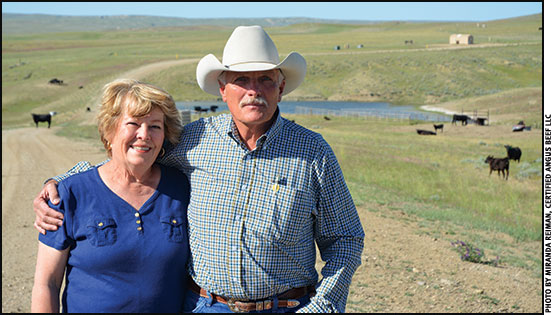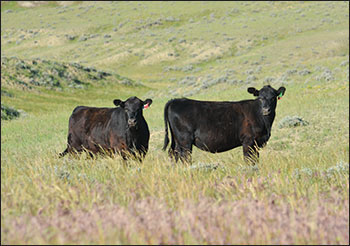
Wyoming Rancher Earns CAB Honors
Dry Fork Land and Cattle earns 2014 CAB® Commercial Commitment to Excellence honors.
As Dee Johnson got familiar with his surroundings, he may have wondered just what he had gotten himself into.
In 1991, the rancher bought nearly 40,000 acres after a foreclosure in northeastern Wyoming. The country was rugged and in great need of a caretaker.
“It wasn’t very damn glamorous, but I had a passion not to fail,” Johnson says. He brought 500 cows up from a family ranch in New Mexico. By day, he tended stock and learned the land. At night he’d return to the sheep-barn-turned-bunkhouse.
“You fought with the rats at night to see who got the bed,” he recalls, able to laugh about those days now. “We ran on so much borrowed money, you couldn’t hardly believe it.”
Any time he and Gaye, his wife of 48 years, did get some cash, it went back into improvements.
On Sept. 19, at its annual conference in Marco Island, Fla., the Certified Angus Beef® (CAB®) brand honored the couple’s Dry Fork Land and Cattle with the Commercial Commitment to Excellence Award for their perseverance in reaching lofty goals.
The single “laid-down, barbed-wire corral” evolved into strategically located facilities all across the ranch. In 2000, they built a 1,100-square-foot cabin. It was another five years before they added electricity.
This frontier lifestyle was a contrast to the ranch where Johnson grew up near Laketown, Utah, where scenery drew people and land values skyrocketed. With his wife and children staying in Utah, visiting during school breaks and summers, Johnson spent a decade “batching it.”
“As far as the cattle deal goes, that’s where our passion is,” Johnson says, “and you have to have land to have cows.”
His herd traces back to some of the first Angus in Utah. In 1964 Johnson’s dad bought 38 Angus heifers from Montana.
“In every aspect, from mothering ability to raising pounds to having less health problems to being a better product when it hits the plate, I’ve thought it was the most productive breed out there,” he says.
Selection always started with phenotypic evaluation, but today that’s coupled with a focus on the numbers. If bulls are “deep-ribbed,” with good feet and structure, backed up with “the right muscle structure in the hindquarters,” then he’ll check out birth weights and expected progeny differences (EPDs) for milk, ribeye and marbling.
“I don’t ever buy a young son out of an unproven sire,” Johnson says.
Rainfall averages around 13 inches, and although the ranch doesn’t get a lot of snow, winters are often cold and windy.

“I just believe if you do your homework, and you’re a true stockman, and you are looking at the cattle, I think you can make ’em better,” Dee Johnson says. “But it takes time to change a cow herd.”
“We have cattle that can look like they are going to starve after a winter blizzard and as soon as they get something to eat they gain so fast and the mothering ability, good milk, good basic structure in these cattle — I don’t think we’ve taken any of that away from the cattle to produce in this environment and still have what we need on the end product,” he says, noting a 97% pregnancy rate and cows that are 12-13 years old.
He also spends a large amount of time selecting replacements.
“The real reward is knowing you’ve done a good job,” he says.
The only way to be sure? Feed them out.
“We decided to forego a sure thing,” Johnson says. “We didn’t know how they would perform, and we didn’t know they would do that well when they got graded. It was risky, but I thought well worth it.”
When he went to Darnall Feedlot near Harrisburg, Neb., owner-manager Gary Darnall quickly found what others already knew of Johnson: “He’s very intense as far as decision making,” the feeder says. “He just lives and breathes and is constantly thinking about ranching.”
The first cattle reached 27% CAB brand acceptance, well above the national average at the time. Today loads reach up to 80% CAB and CAB Prime. Five years of carcass data shows an average of nearly 60% CAB across all the cattle.
“I get a lot of satisfaction out of [feeding cattle], more than the money end of it,” Johnson says.
The Johnsons now graze 1,600 cattle that support three families: their own.
“I think that’s probably brought me the biggest joy of anything, is to have them here,” Johnson says of his two sons. “We know we can depend on family, and that’s what holds this together — the boys have a passion.”

Editor’s Note: For the full-length version of this story, see the cover of the October 2014 Angus Beef Bulletin, which will mail mid-October. If you are not a subscriber, follow this link — http://www.angusbeefbulletin.com/
abb_subscr.html — for free subscription information.





